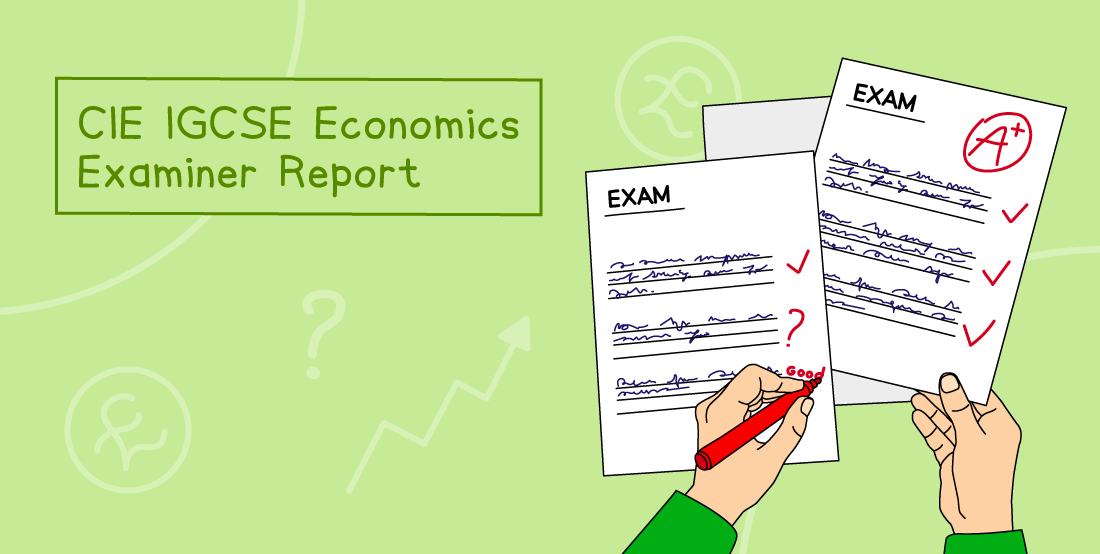CIE IGCSE Economics (0455) Examiner Report 2023: Summary
Written by: Steve Vorster
Reviewed by: Lisa Eades
Published

Contents
This article summarises key takeaways from the CIE IGCSE Economics (0455) examiner report 2023, covering all three time zones. By analysing each report, we’ve identified recurring mistakes, skill gaps and issues with exam technique. Importantly, we provide practical strategies teachers can use immediately to enhance student performance.
To help you make targeted improvements, we’ve grouped examiner insights into key themes that cut across all three time zone papers. These insights include common issues with data interpretation, elasticity, diagram accuracy, evaluation, and terminology. Rather than listing question-by-question feedback, this thematic approach allows you to spot trends, understand root causes, and apply actionable strategies across your teaching.
Whether you're new to teaching CIE IGCSE Economics, looking to adapt your teaching methods, or planning effective revision sessions, this guide equips you with the tools to address the most persistent issues highlighted by the principal examiner.
Data Interpretation and Use of Source Material
What Went Wrong
Ignoring Source Data in Section A: Candidates frequently overlooked source data, even when explicitly instructed to use it.
Failure to Identify Key Trends: For example, in Paper 21 Q1(f), many did not recognise that China and India were net importers of coal despite being large producers.
Superficial Analysis: In Paper 22 Q1(f), students often restated data without making meaningful connections. An example is linking GDP per head with internet access.
Overlooking Clear Patterns: In Paper 23 Q1(f), candidates missed relationships like CO₂ emissions versus GDP, ignoring evident patterns in the provided tables.
Why It Happened
Rushed Responses: Students may have hurried to answer without thoroughly examining graphs and tables.
Misunderstanding Instructions: There was confusion about what "refer to the data" entails, leading to quoting without proper interpretation.
Strategies for Improvement
Exam Technique
Structured Data Analysis: Encourage a "quote → explain → connect" approach. For example:
“China produced 3,640 units of coal but consumed 4,215, indicating a reliance on imports despite high output.”
Revision Tip
Regular Practice with Data Sets: Incorporate past paper tables and graphs in lessons. Prompt students with questions like, “What does this suggest?” and “Why might this be significant?” to foster deeper analysis. I have used datasets like those found at the International Labor Organisation or the Observatory of Economic Complexity. They provide rich visual aids to lesson starters, increase engagement and enhance analytical ability.
Confusion with Elasticity Concepts (PES, PED)
What Went Wrong
Mixing Up Elasticity Types: In Paper 21 Q1(d), students provided demand-based answers to a supply elasticity question.
Conflating Concepts: There was evident confusion between price and productivity, with students often merging the two concepts.
Lack of Specificity: Many failed to specify whether elasticity was increasing or decreasing in their explanations.
Why It Happened
Terminology Confusion: Students struggled to differentiate between similar economic terms.
Misunderstanding Factors Affecting Elasticity: There was a lack of clarity on what influences supply elasticity versus demand elasticity.
Strategies for Improvement
Exam Technique
Clarify Impact on Elasticity: Students should explicitly state the effect on elasticity, e.g., “This makes PES more inelastic due to time lags.”
Avoid Generalisations: Encourage precise language rather than vague statements like “affects elasticity.”
Revision Tip
Comparative Analysis: Use T-charts to contrast PES and PED, listing factors, typical values, and impacts.
Flashcards for Key Concepts: Create flashcards that link factors to their effects on elasticity, such as “Long production time → PES = inelastic.”
Challenges with Drawing and Interpreting Diagrams
What Went Wrong
Incorrect Diagram Adjustments: In Paper 21 Q1(e), students drew new equilibrium points instead of illustrating a maximum price ceiling.
Mislabelling and Reversing Axes: In Paper 22 Q1(e), axes were often mislabelled, or curves were reversed.
Over-Explanation: In Paper 23 Q1(e), students provided lengthy explanations when only a diagram was required.
Why It Happened
Poor Diagram Discipline: Careless labelling and structuring of diagrams.
Uncertainty in Diagram Adjustments: Confusion about when to shift curves versus when to depict price controls.
Strategies for Improvement
Exam Technique
Implement a Diagram Checklist: Ensure students:
Label axes (Price/Quantity).
Label both curves appropriately.
Depict interventions clearly (e.g., price ceiling, subsidy).
Indicate surplus or shortage explicitly.
Revision Tip
Regular Diagram Practice: Conduct weekly “diagram drills” where students sketch and label scenarios. Adding this to my teaching practice was one factor that caused my students to consistently start achieving top grades. The thinking and explanation around the activity deeply embed the learning.
Peer Review Sessions: Encourage students to draw diagrams and have peers assess them using the checklist.
Underdeveloped Evaluation in Extended Responses
What Went Wrong
One-Sided Arguments: In Paper 21 Q1(g/h), students provided unbalanced views on topics like coal and budget deficits.
Lack of Contextual Depth: In Paper 22 Q2(d), responses were theoretically sound but lacked real-world context or opposing perspectives.
Time Management Issues: In Paper 23, overly long answers for ‘define’ and ‘explain’questions led to under-developed answers for the longer ‘analyse’ and ‘discuss’ questions.
Why It Happened
Inefficient Time Allocation: Spending too much time on lower-mark questions.
Absence of Structured Evaluation: Difficulty in organising thoughts for 6/8-mark questions.
Strategies for Improvement
Exam Technique
Teach Structured Responses: Utilise frameworks like PEEL (Point, Explain, Example, Link) or CLA (Claim, Limitation, Application) to organise extended answers.
Emphasise Balanced Arguments: Highlight the necessity of presenting both sides to achieve top marks.
Revision Tip
Practice Evaluative Writing: Use prompts that encourage consideration of multiple perspectives, e.g., “While X may result in Y, this depends on Z…”
Misunderstanding of Economic Terms
What Went Wrong
Confusing Key Terms: Mixing up concepts like budget deficit with current account deficit.
Misusing Terminology: Errors such as using “means of exchange” instead of “medium of exchange.”
Why It Happened
Surface-Level Learning: Relying on rote memorisation without understanding context.
Vague Definitions: Overdependence on imprecise explanations.
Strategies for Improvement
Exam Technique
Contextual Application: Encourage students to verify definitions within the context of the question to ensure appropriateness.
Revision Tip
Vocabulary Application Exercises: Conduct weekly tests where students not only define terms but also apply them in sentences or scenarios. I often play definition games as a plenary activity. Start with one word or concept, for example, indirect tax. Once a student has defined it, they choose a term or concept linked to theirs and ask someone else in the class to define it. Adding a 30-second time limit maintains pace!
Visual Aids: Use diagrams alongside terms and definitions to reinforce understanding.
Final Thoughts
The CIE IGCSE Economics (0455) examiner report 2023 highlighted that many student challenges stemmed from exam technique rather than content knowledge. Common issues included misreading data, misapplying concepts like elasticity, errors in diagrams, and unbalanced evaluations.
Embedding exam techniques into regular teaching - not just revision periods - can significantly enhance student performance. Small, frequent practice with data response, diagrams, and structured evaluation will yield the strongest results.
Enhance Student Outcomes with Save My Exams
Save My Exams is a one-stop revision resource designed to boost success in CIE IGCSE Economics. Developed by experts and trusted by educators globally, our platform offers everything needed for success:
Exam-Style Topic Questions with Worked Solutions: Aligned with examiner expectations to build student confidence.
Printable Revision Guides: Including model answers and structured explanations to develop exam-ready skills.
Evaluation Frameworks and Command Word Training: To improve how students structure high-mark responses.
Past Paper Resources and Examiner Feedback Integration: Ensuring preparation is targeted, efficient, and effective.
Everything is designed to save you time and help your students achieve more - lesson by lesson, exam by exam.
👉 Explore our teacher resources now
Join thousands of teachers already using Save My Exams to raise achievement in IGCSE Economics.
References
Cambridge International. (2023). Cambridge IGCSE Economics (0455) Examiner Report: June 2023 series [Examiner report]. Cambridge Assessment International Education. https://www.cambridgeinternational.org/Images/521315-june-2023-examiner-report.pdf
International Labour Organization (ILO) (2023) ILOSTAT country profiles. Available at: https://ilostat.ilo.org/data/country-profiles/ (Accessed: 14 April 2025).
The Observatory of Economic Complexity (OEC) (2023) Explore the trade data for Guatemala. Available at:https://oec.world/en/visualize/tree_map/hs92/export/gtm/all/show/2023?slug=tree_map&slug=hs92&slug=export&slug=gtm&slug=all&slug=show&slug=2023 (Accessed: 14 April 2025).
Sign up for articles sent directly to your inbox
Receive news, articles and guides directly from our team of experts.

Share this article


 written revision resources that improve your
written revision resources that improve your